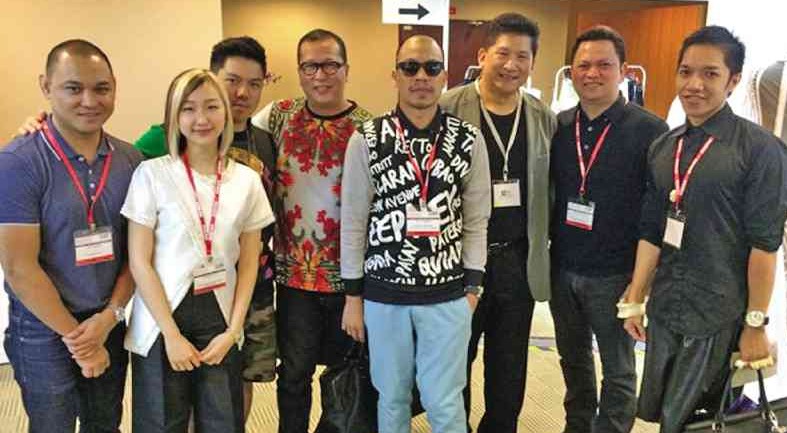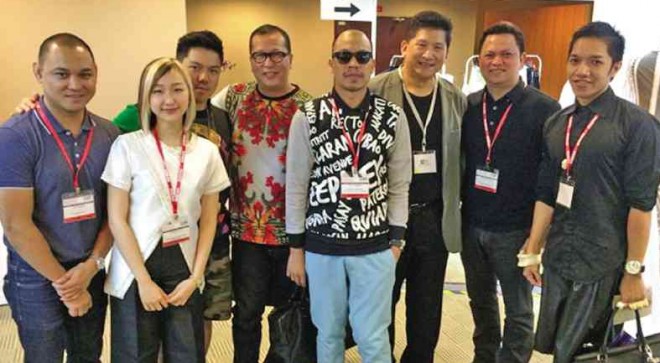
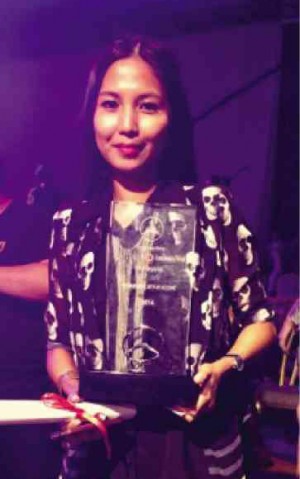
For the second straight year, Filipino designers made a splash in the recent Malaysia Fashion Week (MFW) by presenting distinct but wearable collections.
And before the weeklong event ended at Matrade exhibitions complex in Kuala Lumpur, Albert Andrada ran away with one of three major awards handed out by organizers.
The Middle East-trained Filipino designer won Asia’s Most Connected Designer award mainly on the strength of online voting on Facebook.
Andrada’s feat came in the heels of fellow Filipino Avel Bacudio’s win last year as Asia’s Most Influential Designer. It was the first time the decade-old MFW handed out awards.
This year’s Asia’s Most Influential Designer award went to Malaysian Joe Chia, 27, while Asia’s Most Promising Designer award went to Taiwanese Chun Ting Liu, 29.

With or without Facebook, many felt that Andrada deserved the prize, as the veteran designer showed a well-received 12-piece semi-beaded and embroidered evening wear collection made of chiffon, soft tulle, Mikado silk and various laces.
Inspired by marine life, Andrada’s collection was limited to such colors as white, nude, coral and sea green. Apart from embellishing certain pieces with laser-cut appliqué, he also used tiny shells and crystals.
“The look is still luxurious,” he said, “but the take is totally different from what I’ve done before, including the nude and sequined tulle dress I did for Paris Hilton.”
A joint project of the Malaysian trade department and Singapore-based events organizer Stylo, MFW is also known as Mercedes-Benz Stylo Asia Fashion Week (MBSAFW) after the leading German carmaker became one of the event’s major sponsors last year.
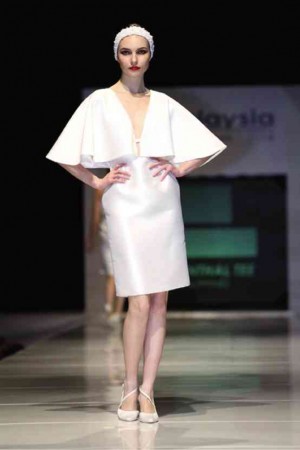
This year’s MFW, which coincided with a lifestyle trade show, drew designers, buyers and journalists from 13 Asian countries, including Japan, China, India, Indonesia, Singapore, Australia and host country Malaysia.
Strong contender
According to an MFW insider, Roland Alzate was also a strong contender for both Asia’s Most Connected and Asia’s Most Promising Designer awards.
Alzate, who has won a string of awards locally since becoming a full-time designer almost three years ago, reportedly came in second to Andrada in terms of Facebook likes.
Like Andrada’s collection, Alzate’s editorial-worthy animal-print ensembles and chain mail-like metallic stretch dresses could stand on their own merits.
The young Filipino designer used animal prints in such color combinations as black and blue, black and red, and black and orange with neutral-colored patent leather panels and oversized zippers to produce strong, attention grabbing dresses and braided jackets.
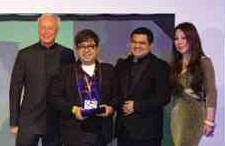
The woven animal prints were made of cotton and others materials like plastic and raffia strips done by Aklan weavers. For his ’70s-inspired metallic jumpsuits and long dresses in shiny blue, silver and lavender, Alzate sourced his fabrics from Hong Kong.
“My dresses have always been big, bold and a bit heavy,” said Alzate. “This season, my silhouettes are basic and almost shapeless. I love incorporating handmade elements because it’s my idea of couture without resorting to too much embellishments.”
He and partner Noel Crisostomo worked with accessories designer and last year’s Look of Style finalist Ron Ramiro for their models’ shoes.
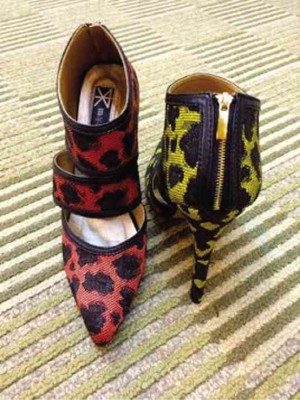
Crisostomo, a veteran Filipino-Canadian designer who once worked for Club Monaco and Ports 1961, also presented his own 12-piece spring-summer collection consisting of pleated and color-blocked dresses made of Mikado silk and silk jacquard.
“I explored cutting, fusing and mixing of fabrics and colors like white, lime green, pink and magenta. For a change, I did asymmetrical color blocking that reminded me of irregularly cut tiles,” said Crisostomo, who studied architecture in Manila before immigrating to Canada sometime in the ’80s.
Validation
According to the same MFW insider, almost all the Filipino designers, including Crisostomo, figured in the nominations.
Crisostomo, a member of the Fashion Design Council of the Philippines (FDCP), and Alzate were recommended by FDCP to show their respective collections in this year’s MFW.
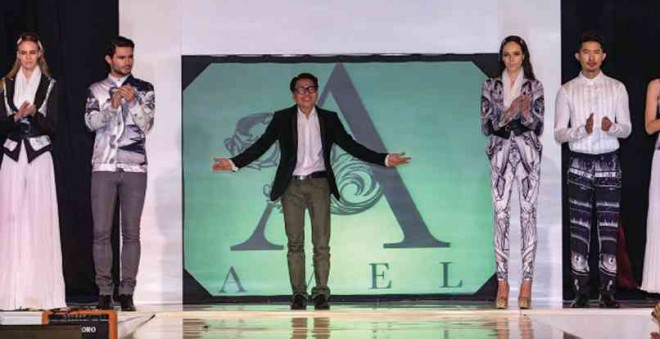
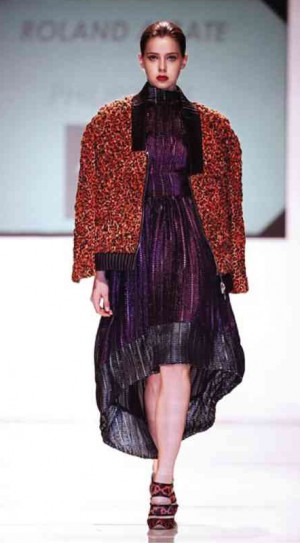
According to Bacudio, also a member of FDCP, the council nominates Filipino designers within its ranks by sending their names and sketches to organizers of MFW. It’s up to organizers to choose whom to invite.
“I consider the award I won last year as a form of validation,” said Bacudio, creative director of direct-selling brand Boardwalk. “Because of it, I gained recognition abroad. Even world-renowned Malaysian shoe designer Jimmy Choo became my friend.”
It also led to the launching last year of Bacudio’s online ready-to-wear label Avel. This year, he presented a collection made of neutral-colored neoprene and chiffon separates printed with images of Philippine church interiors.
“Most of the pieces in the collection are available online,” he said.
Owned and managed by the same people behind Boardwalk, the Avel label gave Bucudio a bigger and more prestigious platform to reach out and tap into the global market.
A day after his show, Alzate also received inquiries from Japanese department store chain Takashimaya regarding the possibility of carrying his line.
Global platform
Apart from the chance of mounting a fashion show for free, participating designers had to shoulder their hotel, airfare and the $2,750 participation fee to be part of MFW.
“Noel and I spent quite a sum to get here, but we feel that it was worth it because this is one fashion week where they really invite foreign buyers and media,” said Alzate. “It gives designers like us a regional and even a global platform to show our clothes.”
The Filipino presence was bolstered by the participation of young designers Rosenthal Tee, Jeffry Rogador and Charles Cua.
A product of London’s Instituto Marangoni, Tee, 26, showed a 12-piece collection consisting of luxury dresses, separates and bridal gowns made of French and Spanish laces, soft tulle, organza, piña and various silk fabrics in ivory and ecru.
Tee’s ready-to-wear bridal dresses and separates with minimal beadwork and appliqué are ideal for resort and civil weddings.
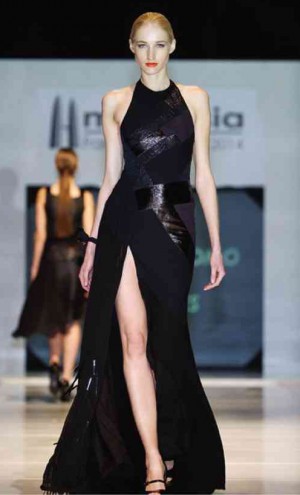
She also did a number of elaborate wedding-day options. Her finale piece, for instance, was a strapless and body-hugging number with drama confined mainly on the gown’s bottom half—a cloud of soft tulle shaped like a bouquet of roses in various sizes.
“I find it funny that I’m debuting in Malaysia and not in the Philippines,” said Tee, who runs a fledgling shop in Marikina. “But I thought it would be a good opportunity for me to create more impact since I’m showing with seasoned colleagues like Noel and Albert.”
Filipino presence
Although Cua was identified as part of the Singaporean contingent, the designer, a trained architect and building engineer, grew up and runs a garment business in the Philippines.
Cua, who did a collection of tailored suits and formal dresses made of printed cotton and organza for the family-owned Azure brand, was representing the Management Institute of Singapore where he studied fashion design.
The Filipino presence extended to Brunei-based designer Maricel Pamintuan, the daughter of Filipino and Chinese immigrants who settled in the tiny, oil-rich Southeast Asian kingdom.
Even the Wearista Style Icon award, a new recognition handed out by Stylo to the most fashion-forward woman in the audience, went to Singapore-based Filipina fashion blogger Mary Jane Tauyan, a native of Laguna and now married to an Australian.

